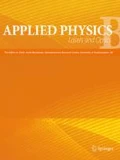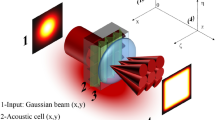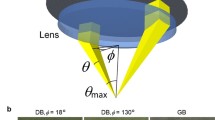Abstract
The use of laser beams made up of ultrafast pulses for the processing of materials can be bothered by the consequences of optical Kerr effect (OKE) cumulated by the propagation through optical devices (windows, laser crystal, prisms, lenses, …). The latter are mainly a reduction of the intensity in the focal plane accompanied by a distortion of the temporal and spatial pulse shape. We present a comparative study on such distortions for Gaussian, super-Gaussian and LG10 (one central peak surrounded by a ring) beams. It is demonstrated that the LG10 beam shows sensitivity to OKE which is smaller than that of the Gaussian LG00, and super-Gaussian beams. As a result, the focusing performances of the LG10 beam are quite superior to that observed with Gaussian or super-Gaussian beam: a higher on-axis intensity, a narrower intensity pattern, and a temporal shape and an energy fluence almost undistorted.





















Similar content being viewed by others
References
M. Deubel, G. Freymann, M. Wegener, S. Pereira, K. Bush, C. Soukoulis, Direct laser writing of three-dimensional photonic-crystal template for telecommunications. Nat. Mater. 3, 444 (2004)
M. Beresna, M. Gecevicius, P.G. Kazansky, Ultrafast laser direct writing and nanostructuring in transparent materials. Adv. Opt. Photon. 6, 293 (2014)
Y. Liao, Y. Cheng, C. Liu, J. Song, F. He, Y. Shen, D. Chen, Z. Xu, Z. Fan, X. Wei, K. Sugioka, K. Midorikawa, Direct laser writing of sub-50nm nanofluidic channels buried in glass for three-dimensional micro-nanofluidic integration. Lab. Chip 13, 1626 (2013)
M. Ams, G.D. Marshall, P. Dekker, J.A. Piper, M.J. Withford, Ultrafast laser written active devices. Laser Photon. Rev. 3, 535 (2009)
B.H. Cumpston et al., Two-photon polymerization initiators for three-dimensional optical data storage and microfabrication. Nature 398, 51 (1999)
F. He, Y. Liao, J. Lin, J. Song, L. Qiao, Y. Cheng, K. Sugioka, Femtosecond laser fabrication of monolithically integrated microfluidic sensors in glass. Sensors 14, 19402 (2014)
S. Gross, M. Withford, Ultrafast-laser-inscribed 3D integrated photonics: challenges and emerging applications. Nanophotonics 4, 332 (2015)
A. Campillo, S. Shapiro, B. Suydam, Periodic breakup of optical beams due to self-focusing. Appl. Phys. Lett. 23, 628 (1973)
M. Feit, J. Fleck, Beam nonparaxiality, filament formation, and beam breakup in the self-focusing of optical beams. JOSA B5, 633 (1988)
J. Caumes, L. Videau, C. Rouyer, E. Freysz, Direct measurement of wave-front distortion induced during second-harmonic generation : application to breakup-integral compensation. Opt. Lett. 29, 899 (2004)
G. Zhu, J. Howe, M. Durst, W. Zipfel, C. Xu, Simultaneous spatial and temporal focusing of femtosecond pulses. Opt. Express 13, 2153 (2005)
C. Jing, Z. Wang, Y. Cheng, Characteristics and applications of spatiotemporally focused femtosecond laser plulses. Appl. Sci. 6, 428 (2016)
A. Hasnaoui, M. Fromager, K. Aït-Ameur, About the validity of the parabolic approximation in Kerr lensing effect. Optik 193, 162986 (2019)
R.W. Boyd, S.G. Lukishova, Y.R. Shen, Self-focusing: past and present, fundamentals and prospects. Springer Top. Appl. Phys. (2009). https://doi.org/10.1007/978-0-387-34727-1
E.S. Bliss, J.T. Hunt, P.A. Renard, G.E. Sommargren, H.J. Weaver, Effects of nonlinear propagation on laser focusing properties. IEEE J. Quantum Electron. 12, 402 (1976)
A.J. Campillo, R.A. Fisher, R.C. Hyer, L. Shapiro, Streak camera investigation of the self-focusing onset in glass. Appl. Phys. Lett. 25, 408 (1974)
B. Yu, Z. Lin, X. Chen, W. Qiu, J. Pu, Impact of nonlinear Kerr effect on the focusing performance of optical lens with high-intensity laser incidence. Appl. Sci. 10, 1945 (2020)
S. Haddadi, O. Bouzid, M. Fromager, A. Hasnaoui, A. Harfouche, E. Cagniot, A. Forbes, K. Ait-Ameur, Structured Laguerre–Gaussian beams for mitigation of spherical aberration in tightly focused regimes. J. Opt. 20, 045602 (2018)
J. Pu, H. Zhang, Intensity distribution of Gaussian beams focused by a lens with spherical aberration. Opt. Commun. 151, 331–338 (1998)
C.Y. Liao, M. Bouriaund, P.L. Baldeck, J.C. Léon, C. Masclet, Two-dimensional slicing method to speed up the fabrication of micro-objects based on two-photon polymerization. Appl. Phys. Lett. 91, 033108 (2007)
K.S. Lee, R.H. Kim, D.Y. Yang, S.H. Park, Advances in 3D nano/microfabrication using two-photon initiated polymerization. Prog. Polym. Sci. 33, 631 (2008)
W. Denk, J.H. Strickler, W.W. Webb, Two-photon laser scanning fluorescence microscopy. Science 248, 73 (1990)
J.A. Glaze, High energy glass lasers. Opt. Eng. 15, 136 (1976)
J.A. Hermann, Simple model for a passive optical power limiter. Opt. Acta 32, 541 (1985)
A.A. Ishaaya, N. Davidson, G. Machavariani, E. Hasman, A.A. Friesem, Efficient selection of high-order Laguerre–Gaussian modes in a Q-switched Nd:YAG Laser. IEEE J. Quantum Electron 39, 74 (2003)
G. Machavariani, Effects of phase errors on high order mode selection with intracavity phase element. Appl. Opt. 43, 6328 (2004)
E. Cagniot, M. Fromager, T. Godin, N. Passilly, M. Brunel, K. Aït-Ameur, A variant of the method of Fox and Li dedicated to intracavity laser beam shaping. JOSA A 28, 489 (2011)
W.W. Rigrod, Isolation of axi-symmetrical optical-resonator modes. Appl. Phys. Lett. 2, 51 (1963)
K.M. Abramski, H.J. Baker, A.D. Colley, R.R. Hall, Single-mode selection using coherent imaging within a slab waveguide CO2 laser. Appl. Phys. Lett. 60, 2469 (1992)
A. Hasnaoui, K. Aït-Ameur, Properties of a laser cavity containing an absorbing ring. Appl. Opt. 49, 4034 (2010)
M. Ciofini, A. Labate, A. Meucci, P.Y. Wang, Experimental evidence of selection and stabilization of spatial patterns in a CO2 laser by means of spatial perturbations. Opt. Commun. 154, 307 (1998)
S. Ngcobo, K. Aït-Ameur, N. Passilly, A. Hasnaoui, A. Forbes, Exciting higher-order radial Laguerre–Gaussian modes in a diode-pumped solid state laser resonator. Appl. Opt. 52, 2093 (2013)
A. Bencheikh, M. Fromager, K. Aït-Ameur, Generation of Laguerre–Gaussian LGp0 beams using binary phase diffractive optical elements. Appl. Opt. 53, 4761 (2014)
I.S. Gradshteyn, I.M. Ryzhik, Table of Integrals, Series and Products, 7th edn. (Elsevier, New York, 2007), p. 337
A. Forbes, Chap. 7. Laser Beam Propagation (CRC Press Taylor & Francis Group, 2014).
S. Scholes, H. Sroor, K. Aït-Ameur, Q. Zhan, A. Forbes, General design principle for structured light lasers. Opt. Express 28, 35006 (2020)
L.A. Romero, F.M. Dickey, Lossless laser beam shaping JOSA A 13, 751 (1996).
S. Scholes, V. Rodriguez-Fajardo, A. Forbes, Lossless reshaping of structured light. arXiv:2004.10196v2 [Physics Optics] (2020)
V.N. Mahajan, Optical Imaging and Aberrations, Part I (SPIE Optical Engineering Press, Bellingham, 1998).
V.N. Mahajan, Zernike circle polynomial and optical aberrations of system with circular pupils. Appl. Opt. 33, 8121 (1994)
V.N. Mahajan, Zernike-Gauss polynomials and optical aberrations of systems with Gaussian pupils. Appl. Opt. 34, 8057 (1995)
S. Legmizi, A. Hasnaoui, B. Boubaha, A. Aissani, K. Ait-Ameur, On the different ways for defining the effective focal length of a Kerr lens effect. Laser Phys. 27, 106201 (2017)
Author information
Authors and Affiliations
Corresponding author
Ethics declarations
Conflict of interest
The authors declare no conflict of interest.
Additional information
Publisher's Note
Springer Nature remains neutral with regard to jurisdictional claims in published maps and institutional affiliations.
Appendices
Appendix
Kerr lens modelling for LG00 and LG10 beams
In the next, we will present a modelling of the Kerr lensing effect induced by LG00 and LG10 based on the Zernike polynomial decomposition. The propagating term of the collimated incident beam emerging from the Kerr medium is written \(\exp \left[ {ikW(\rho )} \right]\), where \(kW(\rho ) = - \Delta \varphi (\rho )\). The phase distribution \(W(\rho )\) is usually called as wave aberration function (WAF) according to the terminology of optical aberration modelling [39]. The WAF is expanded as a linear combination of Zernike polynomials (ZP), \(Z_{j}\), as follows
where the index j is a polynomial-ordering number, and \(a_{j}\) the aberration coefficients. The normalised radial coordinate \(\overline{\rho }\) is equal to \(\rho /R\), where R is the radius of the unit circle. In the following we set R equal to 1.5 W (2.5 W) since the circle of radius 1.5 W (2.5 W) contains 99% of the incident LG00 (LG10) beam power. The Zernike polynomials \(Z_{j} (\overline{\rho },\theta )\) are a set of orthogonal functions over the unit circle (\(0 \le \overline{\rho } \le 1\)). Table 2 gives the corresponding ZP’s [40].
For the calculation of the aberration coefficient \(a_{j}\).we will take into account the amplitude profile \(E(\rho )\) of the incident beam [41]:
where \(E(\overline{\rho })\) stands for \(E_{1} (\overline{\rho })\), when the incident beam is a LG00 and \(E_{2} (\overline{\rho })\) for a LG10:
The nonlinear phase shift \(\Delta \varphi (\overline{\rho })\) stands for \(\Delta \varphi_{1}\) and \(\Delta \varphi_{2}\), given by Eqs. (8) and (9), and by taking into account the normalisation of the radial coordinate rewrite as
The sum in Eq. (17) is infinite, but is usually truncated. Here, we will work arbitrarily until j = 22, and because of the rotational symmetry of \(\Delta \varphi\) most of coefficients \(a_{j}\) are equal to zero except four of them: a1, a4, a11 and a22.
In the following, we will use the dimensionless aberration coefficients Aj which are expressed in unit of wavelength, and is defined as \(A_{j} = a_{j} /\lambda\). By taking into account the expressions of \(E(\overline{\rho })\) and \(\Delta \varphi (\overline{\rho })\) we get finally.
For LG00:
For LG10:
The integrals in Eq. (23) and (24) are solved numerically using a FORTRAN routine based on the numerical integrator dqdag from the International Mathematics and Statistical Library (IMSL). The results are given in Table 3:
It has been already shown [42] that it is possible to deduce an equivalent focal length \(\sqrt 3 R^{2} /(12\lambda A_{4} )\), noted \(f_{K0}\), for LG00 input, and \(f_{K1}\), for LG10 input, from the aberration coefficients \(A_{4}\) and \(A_{4}^{^{\prime}}\):
For LG00:
For LG10:
The first remark that could be made from the above is that the Kerr lensing effect induced by a LG00 (LG10) is a converging (diverging) lensing effect which has a tendency to shift the best focus point toward (away) the lens. In addition, Eqs. (25) and (26) show that \(\left| {f_{K1} } \right| > > \left| {f_{K0} } \right|\) and that explains the focal shift behaviour illustrated in Fig. 3.
The position \(z_{F0}\) (\(z_{F1}\)) of the best focus when the input is a LG00 (LG10) beam in the framework of the above Kerr lens modelling is given by
The results are shown in Fig. 17, for t = 0, which displays the best focus position \(z_{F0}\) and \(z_{F1}\), resulting from the above Kerr lens modelling for LG00 and LG10 input, and position \(z_{\max }\) calculated from the on-axis intensity distribution. The agreement between the Kerr lens modelling (\(z_{F0}\) and \(z_{F1}\)) and the position \(z_{\max }\) of the best focus is not perfect but satisfactory at the very least concerning the trend in focus shift due to optical Kerrr effect (Fig. 22).
Validity of Fresnel–Kirchhoff integral for ultrashort pulses
The well-known Fresnel–Kirchhoff integral given by Eq. (5) assumes that the incident wave is monochromatic, and this is rigorously not the case when the incident beam is an ultrashort pulse. The time variation of the electric field associated with the laser pulse takes the following form
The spectral content \(E(\omega )\) is deduced from the following Fourier transform
The spectral width (at half-maximum) is equal to \(\Delta \omega = \sqrt {\ln 2} /(\pi \tau )\). If one considers a central wavelength \(\lambda_{0} = 1064nm\) we obtain the width \(\Delta \lambda\) of the spectral distribution
If one takes into account Eq. (4), we can estimate the variation \(\Delta \varphi_{0}\) of the nonlinear on-axis phase shift which is the key parameter of the diffracted field distribution:
The following table (Table 4) shows that for a pulse duration \(\tau > 100fs\), the resulting variation of the nonlinear on-axis phase shift is too small for having a significant influence on the diffracted field. As a result, in these conditions we can use the classical Fresnel–Kirchhoff integral for calculating the pattern in plane \(z = f_{L}\).
In the case where the pulse duration \(\tau\) is too short, the application of Eq. (4) is not valid and the calculation of the diffracted field should need to take into account the finite spectrum.
Rights and permissions
About this article
Cite this article
Hasnaoui, A., Fromager, M., Cagniot, E. et al. Structuring a laser beam subject to optical Kerr effect for improving its focusing properties. Appl. Phys. B 127, 75 (2021). https://doi.org/10.1007/s00340-021-07602-z
Received:
Accepted:
Published:
DOI: https://doi.org/10.1007/s00340-021-07602-z





